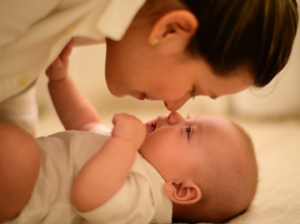And God blessed them and said to them, ‘Be fruitful and multiply and fill the earth’ … Genesis 1:28
 In a recent article in The Wall Street Journal entitled, “A Woman Doesn’t Need an Office to Be Empowered,” Erica Komisar, LCSW, makes the point that “a woman’s value isn’t only a matter of how much she can earn, and women’s leadership should be understood to include nurturing … nurturing children is the most significant and meaningful work a person can do.” In her research Ms. Komisar concluded that:
In a recent article in The Wall Street Journal entitled, “A Woman Doesn’t Need an Office to Be Empowered,” Erica Komisar, LCSW, makes the point that “a woman’s value isn’t only a matter of how much she can earn, and women’s leadership should be understood to include nurturing … nurturing children is the most significant and meaningful work a person can do.” In her research Ms. Komisar concluded that:
Babies are fascinating to observe and interact with, and their development is astonishingly and beautifully subtle while being dramatic at the same time … [it’s] like being with a piece of art you didn’t see completely at first, but after a second and third look you are enthralled … for every subtle gesture a baby makes, her brain cells are multiplying by the thousands … Have you ever looked into the night sky for a shooting star or meteor shower? If you get bored and look away, you’ll probably miss the show.
While there is an ongoing debate about what constitutes “woman’s work” and the practicality of Paul’s words to Titus (2:3-4): Older women, likewise are to … teach what is good and so train the young women to love their husbands, and children … working at home …,” science is beginning to confirm the importance of the mother’s active engagement and presence in the growth of her children, especially during those early years.
In her book, Being There, Why Prioritizing Motherhood in the First Three Years Matters,* Ms. Komisar wrote that researchers are learning about the accelerated development of a child’s brain the first three years of life, doubling in size the first year, and the bonding and attachment processes with the mother – the one she knew in the womb – that cultivate a child’s healthy emotional (right brain) development. While much emphasis today is placed on cognitive learning (left brain), if prioritized before the nurture of the relational and emotional needs of the child are met, in her opinion, it’s like putting shoes on before socks.
In reading the chapter entitled, “Presence 101, Being Present and Engaged to Meet Your Baby’s Needs,” I felt some guilt setting in. I was home with my sons, but often into multi-tasking. Given the values dominating our culture today, it’s easy to understand why young moms can be tempted to think they have more rewarding things to do than care for young children. Quoting an African proverb, Ms. Komisar confirmed the very thing that the apostle Paul wrote about – the importance of intergenerational support: “It takes a village to care for a new mother.”
This is where those of us who are “older women” can help. Some of us can remember the trauma of childbirth and the on-going and sometimes thankless demands of caring for infants. The new mom may not have had an experience as a young child of a warm, intimate relationship with her own mother; she may feel conflicted about not living up to her potential or contributing to the family income; there may be some real economic pressures for the family; and she might think because she’s not very good at being a full-time mother opting instead for another caregiver might be in the child’s best interest; some may struggle with the thought of even risking motherhood.
Very likely there’s a young woman in your orbit who needs some encouragement and may need a break. How might you come alongside to remind her of the unique honor God has granted us as females to bear, nurture, and establish children in the security and goodness of Christ as experienced through the mother’s loving presence? We don’t want these young moms to miss the show!
“So even to old age … O God, do not forsake me, until I proclaim your might to another generation …” Psalm 71:18

* Being There, Why Prioritizing Motherhood in the First Three Years Matters, Erica Komisar, LCSW, Penguin Random House, LLC, New York, NY, 2017.
